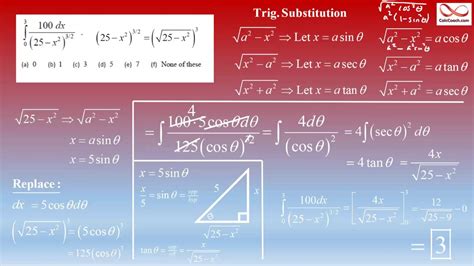The Allure of Trig Substitution
Trig substitution, a cornerstone of integral calculus, empowers students to effortlessly tackle complex integrals involving intricate functions. By employing trigonometric functions as a bridge between seemingly insurmountable integrands and simpler expressions, this technique simplifies integration, unlocking a treasure trove of mathematical insights.

Advantages of Trig Substitution
- Enhanced Integration: Substitutions transform complex integrands into more manageable forms, allowing for straightforward integration.
- Improved Accuracy: Trig identities and relationships ensure accurate results, minimizing the risk of computation errors.
- Greater Confidence: By mastering trig substitution, students gain confidence in their ability to handle challenging integrals.
Common Trig Substitutions
Various trigonometric substitutions exist, each tailored to specific integrand patterns. Some of the most prevalent substitutions include:
| Substitution | Pattern | Example |
|---|---|---|
| Sin substitution | Integrand contains √(a² – x²) | ∫√(4 – x²)dx |
| Cos substitution | Integrand contains √(a² + x²) | ∫√(9 + x²)dx |
| Tan substitution | Integrand contains x² + 1 | ∫x³√(x² + 1)dx |
| Sec substitution | Integrand contains √(x² – a²) | ∫√(x² – 4)dx |
| Csc substitution | Integrand contains √(a²x² – 1) | ∫√(9x² – 1)dx |
Steps for Trig Substitution
- Identify the pattern: Analyze the integrand to determine the most appropriate trig substitution.
- Make the substitution: Replace the relevant variable in the integrand with its trigonometric counterpart.
- Simplify the integrand: Use trigonometric identities and algebraic manipulations to transform the integrand into a simpler form.
- Integrate the simplified integrand: Apply standard integration techniques to find the antiderivative.
- Revert the substitution: Utilize algebraic processes to replace the trigonometric substitution with the original variable.
Applications of Trig Substitution
The applications of trig substitution extend far beyond academic settings. This technique finds practical use in a diverse range of fields, including:
- Physics: Modeling oscillatory motion and calculating energy in vibrating systems.
- Engineering: Analyzing structural vibrations and designing bridges and buildings.
- Computer Graphics: Generating smooth curves and surfaces in computer-aided design.
- Medicine: Modeling physiological processes, such as blood flow and heart rhythms.
- Economics: Forecasting economic trends and analyzing market fluctuations.
Key Insights
- Trig substitution provides a powerful analytical tool for conquering complex integrals.
- The choice of trigonometric substitution depends on the pattern of the integrand.
- Proper implementation of trig substitution requires careful attention to algebraic manipulations and trigonometric identities.
- Applications of trig substitution permeate various disciplines, contributing to advancements in science, engineering, and beyond.
Case Studies: Real-World Applications
Case Study 1: Predicting Tides
Scientists utilize trig substitution to model tidal patterns. By incorporating trigonometric functions into their calculations, they can accurately predict the timing and height of tides, ensuring safe navigation and facilitating maritime activities.
Case Study 2: Designing Wind Turbines
Engineers leverage trig substitution to design and optimize wind turbine blades. By analyzing the aerodynamic forces acting on the blades using trigonometric equations, they can maximize energy efficiency and minimize noise pollution.
Case Study 3: Generating Computer-Animated Scenes
In the realm of computer animation, trig substitution plays a crucial role in creating smooth, lifelike motions. It allows artists to manipulate objects using trigonometric functions, resulting in realistic and visually appealing animations.
Conclusion
Trig substitution stands as an indispensable tool in the mathematical arsenal. Its ability to simplify complex integrals and uncover hidden patterns has revolutionized our understanding of calculus. From scientific research to practical applications, trig substitution continues to push the boundaries of human ingenuity. By mastering this technique, students and practitioners alike can unlock a world of analytical possibilities.
